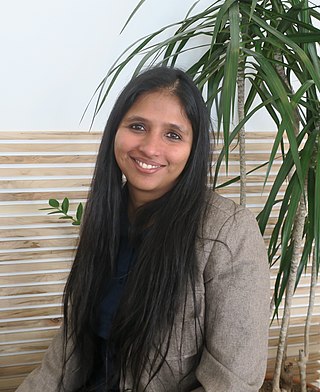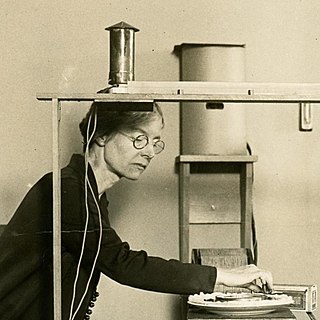Related Research Articles

Vera Florence Cooper Rubin was an American astronomer who pioneered work on galaxy rotation rates. She uncovered the discrepancy between the predicted and observed angular motion of galaxies by studying galactic rotation curves. These results were later confirmed over subsequent decades. Her work on the galaxy rotation problem was cited by others as evidence for the existence of dark matter. The Vera C. Rubin Observatory in Chile is named in her honor.

Cecilia Payne-Gaposchkin was a British-American astronomer and astrophysicist. In her 1925 doctoral thesis she proposed that stars were composed primarily of hydrogen and helium. Her groundbreaking conclusion was initially rejected by leading astrophysicists, including Henry Norris Russell, because it contradicted the science of the time, which held that no significant elemental differences distinguished the Sun and Earth. Independent observations eventually proved that she was correct.

Eleanor Margaret Burbidge, FRS (née Peachey; 12 August 1919 – 5 April 2020) was a British-American observational astronomer and astrophysicist. In the 1950s, she was one of the founders of stellar nucleosynthesis and was first author of the influential B2FH paper. During the 1960s and 1970s she worked on galaxy rotation curves and quasars, discovering the most distant astronomical object then known. In the 1980s and 1990s she helped develop and utilise the Faint Object Spectrograph on the Hubble Space Telescope. Burbidge was also well known for her work opposing discrimination against women in astronomy.

Margaret Lindsay, Lady Huggins, born Margaret Lindsay Murray, was an Irish-English scientific investigator and astronomer. With her husband William Huggins she was a pioneer in the field of spectroscopy and co-wrote the Atlas of Representative Stellar Spectra (1897).
Ruth Marion Lynden-Bell, FRS is a British chemist, emeritus professor of Queen's University Belfast and the University of Cambridge, and acting President of Murray Edwards College, Cambridge from 2011 to 2013.

Margaret Eliza Maltby was an American physicist notable for her measurement of high electrolytic resistances and the conductivity of very dilute solutions. Maltby was the first woman to earn a Bachelor of Science degree from the Massachusetts Institute of Technology, and the first woman to earn a Ph.D. in physics from any German university.

Frances Elizabeth Somerville Alexander was a British geologist, academic, and physicist, whose wartime work with radar and radio led to early developments in radio astronomy and whose post-war work on the geology of Singapore is considered a significant foundation to contemporary research. Alexander earned her PhD from Newnham College, Cambridge, and worked in Radio Direction Finding at Singapore Naval Base from 1938 to 1941. In January 1941, unable to return to Singapore from New Zealand, she became Head of Operations Research in New Zealand's Radio Development Lab, Wellington. In 1945, Alexander correctly interpreted that anomalous radar signals picked up on Norfolk Island were caused by the sun. This interpretation became pioneering work in the field of radio astronomy, making her one of the first women scientists to work in that field, albeit briefly.
Alexander Oliver Rankine was a British physicist who worked on the viscosity of gases, molecular dynamics, optics, acoustics and geophysics.

Wendy Laurel Freedman is a Canadian-American astronomer, best known for her measurement of the Hubble constant, and as director of the Carnegie Observatories in Pasadena, California, and Las Campanas, Chile. She is now the John & Marion Sullivan University Professor of Astronomy and Astrophysics at the University of Chicago. Her principal research interests are in observational cosmology, focusing on measuring both the current and past expansion rates of the universe, and on characterizing the nature of dark energy.

Margaret Galland Kivelson is an American space physicist, planetary scientist, and distinguished professor emerita of space physics at the University of California, Los Angeles. From 2010 to the present, concurrent with her appointment at UCLA, Kivelson has been a research scientist and scholar at the University of Michigan. Her primary research interests include the magnetospheres of Earth, Jupiter, and Saturn.

Helen Frances Gleeson OBE FInstP is a British physicist who specialises in soft matter and liquid crystals. She is Cavendish Professor and former Head of the School of Physics at the University of Leeds.
Frances Gertrude Wick was an American physicist known for her studies on luminescence.
Mary Teresa Brück was an Irish astronomer, astrophysicist and historian of science, whose career was spent at Dunsink Observatory in Dublin and the Royal Observatory Edinburgh in Scotland.

Shohini Ghose is a quantum physicist and Professor of Physics and Computer Science at Wilfrid Laurier University. She has served as the president of the Canadian Association of Physicists (2019-2020), co-editor-in-chief of the Canadian Journal of Physics, and the Director of the Laurier Centre for Women in Science. She was named a 2014 TED Fellow and a 2018 TED Senior Fellow. In 2019 she appeared on the Star TV show TED Talks India Nayi Baat hosted by Shah Rukh Khan. In 2017 she was elected to the Royal Society of Canada's College of New Scholars, Artists and Scientists. Her book Clues to the Cosmos was released in India in December 2019. In 2020, she was selected as an NSERC Chair for Women in Science and Engineering.

This is a timeline of women in science, spanning from ancient history up to the 21st century. While the timeline primarily focuses on women involved with natural sciences such as astronomy, biology, chemistry and physics, it also includes women from the social sciences and the formal sciences, as well as notable science educators and medical scientists. The chronological events listed in the timeline relate to both scientific achievements and gender equality within the sciences.

Louise Sherwood McDowell was an American physicist and educator. She spent most of her career as a professor of physics at Wellesley College and is best known for being one of the first female scientists to work at the United States Bureau of Standards, now the National Institute of Standards and Technology.
Barbara Ann Williams is an American radio astronomer who was the first African-American woman to earn a PhD in astronomy. Her research largely focused on compact galaxy groups, in particular observations of their emissions in the H I region in order to build up a larger scale picture of the structure and evolution of galaxies. Williams was named as the Outstanding Young Woman of America in 1986. She is a retired associate professor in the Department of Physics and Astronomy at the University of Delaware.
Lucy Frear Fortson is an American astronomer known for her work on gamma-ray astronomy and Galaxy morphological classification and for her leadership of citizen science projects including the Galaxy Zoo and Zooniverse. She is a professor in the School of Physics and Astronomy at the University of Minnesota.

Audrey Doris Jones was an English material scientist and a senior lecturer in the department of applied acoustics at the University of Salford. She made important contributions to the theory of the Johnsen–Rahbek effect, the electrical and thermal conductivity of semiconductors, and the thermal resistance of building insulation. She was the only daughter of Frederick Stuckes, the general manager of a shipbroking firm, and was educated at Colston's Girls' School in Bristol. In 1942, she won a scholarship to study the Natural Science Tripos at Newnham College in the University of Cambridge.
Mary Chilton Noyes was a physicist known for being the first woman to earn a PhD from Western Reserve University and one of the first women to earn a PhD in physics from a United States institution.
References
- 1 2 Ogilvie, Marilyn Bailey; Harvey, Joy Dorothy (2000-01-01). The Biographical Dictionary of Women in Science: L-Z. Taylor & Francis. ISBN 9780415920407.
- ↑ "The Western College at the Front". The New York Observer. July 14, 1910. p. 62.
- ↑ Mann, Wilfrid Basil (2014). Was There a Fifth Man?: Quintessential Recollections. Elsevier. p. 15. ISBN 978-1483147130.
- ↑ "Minutes". Proceedings of the Royal Institution of Great Britain. 36 (1–3). ISSN 0035-8959.